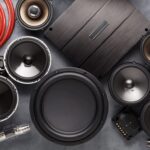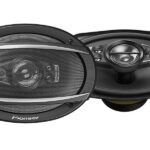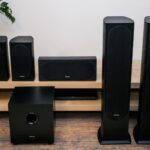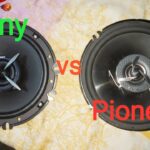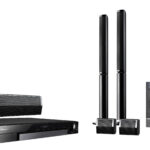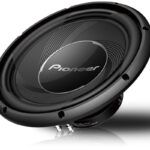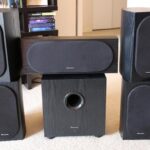The main difference between a JBL subwoofer with LFE (low-frequency effects) and a normal subwoofer is that the LFE subwoofer is specifically designed for reproducing low-frequency sounds found in movies and music, while a normal subwoofer is more versatile and can handle a wider range of frequencies. When it comes to choosing a subwoofer, understanding the distinction between a JBL subwoofer with LFE and a normal subwoofer is crucial.
The LFE subwoofer is designed to accurately reproduce low-frequency effects commonly found in movies and music, providing a more immersive listening experience. On the other hand, a normal subwoofer offers a broader frequency response, making it capable of handling a wider range of frequencies.
This makes it a more versatile option for those who desire deep bass in various audio applications. By understanding your specific audio needs and preferences, you can make an informed decision on which type of JBL subwoofer to choose.
What Is A Subwoofer?
A subwoofer is an essential component of a sound system that is designed specifically to reproduce low-frequency audio signals. It is responsible for producing deep bass sounds, adding depth, richness, and texture to the overall audio experience. While regular speakers are capable of producing some low-frequency sounds, a subwoofer enhances the audio quality by focusing on the lower end of the frequency spectrum.
Definition and Purpose
A subwoofer can be defined as a specialized speaker that is dedicated to reproducing low-frequency sounds, typically below 100 Hz. It is a speaker specifically designed to handle these low frequencies with greater accuracy and power. Unlike regular speakers, a subwoofer is focused solely on creating deep, impactful bass that can be felt as well as heard.
The primary purpose of a subwoofer is to provide an immersive audio experience by filling in the low-frequency gaps that regular speakers are incapable of reproducing accurately. It adds depth and realism to music, movies, and other audio content, allowing you to hear and feel the full spectrum of sound. Additionally, a subwoofer is crucial for maintaining balance within a sound system, preventing distortion and muddiness that can occur when regular speakers attempt to reproduce bass frequencies they are not capable of handling effectively.
Importance of a Subwoofer in a Sound System
The importance of a subwoofer in a sound system cannot be overstated. Here are some key reasons why a subwoofer is essential:
- Achieving a full-range sound: By handling low-frequency sounds independently, a subwoofer ensures that every note and nuance is reproduced accurately, allowing for a more complete audio experience.
- Enhancing music listening: A subwoofer adds depth and impact to music, particularly genres like rock, hip-hop, and electronic music, where bass plays a significant role.
- Elevating movie and gaming experiences: Explosions, rumbling engines, and other sound effects are brought to life with a subwoofer, making movies and games more immersive and realistic.
- Improving overall sound quality: A subwoofer takes the strain off regular speakers by handling the low-frequency sounds, allowing them to focus on mid and high-range frequencies. This results in cleaner, more accurate sound reproduction.
- Creating a balanced soundstage: A subwoofer ensures that the sound remains balanced across the entire frequency range, preventing the audio from sounding lopsided or lacking in bass.
In conclusion, a subwoofer is an integral part of any sound system, providing the crucial bass foundation that regular speakers cannot replicate. Its ability to reproduce low-frequency sounds accurately and powerfully enhances the audio experience, whether you’re listening to music, watching movies, or playing video games. Incorporating a subwoofer into your sound system ensures that you can enjoy the full range of sounds as they were intended to be heard.
Jbl Subwoofer Lfe Explained
When it comes to home cinema systems and audio enthusiasts, having a powerful and immersive bass is crucial for an outstanding audio experience. This is where JBL Subwoofers come into play. Among their various subwoofer options, JBL offers the LFE (Low-Frequency Effects) variant, which takes the bass experience to a whole new level.
Understanding LFE (Low-Frequency Effects)
LFE, or Low-Frequency Effects, refers to the lowest frequencies in the audio spectrum that are usually associated with deep bass and rumbling sounds. These frequencies range from 20Hz to 120Hz and add depth and impact to movie sound effects, music and gaming. LFE channels in home cinema systems are specifically designed to handle these low frequencies, allowing you to feel the powerful vibrations and intense bass in your favorite content.
How JBL Subwoofers enhance LFE
JBL Subwoofers are engineered to deliver exceptional bass performance, and the LFE variant takes it to the next level. With advanced technologies like amplifiers, drivers, and bass reflex designs, JBL Subwoofer LFE models enhance the Low-Frequency Effects for a more immersive audio experience. The dedicated LFE channel provides precise control and reproduces the lowest frequencies with accuracy, ensuring every beat and rumble is felt throughout the room.
Additionally, JBL Subwoofers feature adjustable crossover frequency and phase control, enabling you to fine-tune the bass response according to your preference and room acoustics. This customization ensures a seamless integration with your existing audio setup and optimizes the LFE impact for an enhanced cinematic experience.
Key features of JBL Subwoofer LFE
Here are some key features of JBL Subwoofer LFE:
| Feature | Description |
| Powerful Amplifiers | The LFE variant of JBL Subwoofers is equipped with powerful amplifiers that deliver consistent and controlled bass performance, even at high volumes. |
| Premium Drivers | JBL Subwoofer LFE models incorporate premium drivers that are specially designed to handle low frequencies with precision and clarity for an immersive audio experience. |
| Bass Reflex Design | The bass reflex design enhances the efficiency and impact of the low-frequency reproduction, resulting in deeper and more impactful bass. |
| Customizable Controls | JBL Subwoofer LFE allows you to adjust the crossover frequency and phase control to achieve the perfect balance of bass in your listening environment. |
With these key features, JBL Subwoofers provide an exceptional LFE experience that brings your movies, music, and games to life, allowing you to feel every beat and immerse yourself in the audio.
Whether you are a avid home cinema enthusiast or a music lover seeking powerful bass, JBL Subwoofer LFE is a top choice that promises to elevate your audio experience to new heights.
Jbl Subwoofer Normal Explained
When it comes to enhancing the audio experience, JBL Subwoofers are renowned for their exceptional performance. Among the options available, JBL Subwoofer Normal stands out as an incredible choice that delivers impressive bass and depth to your sound system. In this article, we will delve into the characteristics and key features of the JBL Subwoofer Normal, shedding light on what makes it a top-notch audio accessory.
Characteristics of JBL Subwoofer Normal
The JBL Subwoofer Normal offers distinct characteristics that contribute to its superior sound performance:
- Powerful Bass: With its robust build and advanced technology, the JBL Subwoofer Normal produces deep bass frequencies, immersing you in a rich and vibrant audio experience.
- High Sensitivity: The subwoofer’s high sensitivity enables it to efficiently convert the incoming audio signal into powerful sound waves, ensuring every beat and note are reproduced accurately.
- Wide Frequency Response: The JBL Subwoofer Normal has a wide frequency response, allowing it to reproduce both low and mid-range frequencies with precision, resulting in a well-balanced sound output.
- Compact Design: Despite its impressive performance, the JBL Subwoofer Normal features a sleek and space-saving design, making it suitable for various setups and room sizes.
Key features of JBL Subwoofer Normal
JBL Subwoofer Normal offers several key features that enhance your audio setup:
| Features | Description |
|---|---|
| Built-in Amplification | The JBL Subwoofer Normal comes with built-in amplification, eliminating the need for an external amplifier and allowing for seamless integration with your existing audio system. |
| Adjustable Crossover | With its adjustable crossover settings, you have control over the frequency range at which the JBL Subwoofer Normal operates. This feature enables you to fine-tune the bass according to your preferences and room dynamics. |
| Auto Power On/Off | The subwoofer is equipped with an auto power on/off feature, which automatically turns it on when an audio signal is detected and switches it off when there is no signal present. This energy-saving feature enhances convenience and efficiency. |
| Multiple connectivity options | The JBL Subwoofer Normal offers multiple connectivity options, including RCA and speaker level inputs, making it compatible with a wide range of audio devices and systems. |
Comparison with JBL Subwoofer LFE
While both the JBL Subwoofer Normal and JBL Subwoofer LFE are exceptional choices, they serve different purposes in enhancing your audio experience:
- JBL Subwoofer Normal: This model is perfect for individuals who seek a versatile subwoofer that delivers excellent bass performance while maintaining a compact design. It offers adjustable crossover settings and multiple connectivity options, providing flexibility in setup and usage.
- JBL Subwoofer LFE: On the other hand, the JBL Subwoofer LFE is specially designed for home theater systems and larger audio setups. It focuses on reproducing extremely low frequencies, making it ideal for creating a cinematic and immersive listening experience.
In conclusion, the JBL Subwoofer Normal is a powerful and reliable subwoofer that delivers outstanding bass performance and enhances your overall audio system. Its characteristics, key features, and compact design make it a versatile choice suitable for various setups and room sizes. So, if you are looking to elevate your audio experience, the JBL Subwoofer Normal is definitely worth considering.

Credit: reverb.com
Differences Between Jbl Subwoofer Lfe And Normal
Choosing the right subwoofer can significantly enhance your audio experience, whether you’re a movie enthusiast or a music lover. When it comes to JBL subwoofers, two popular options are the LFE and Normal models. While both deliver powerful bass and complement your existing audio setup, there are several key differences between the two. In this article, we will explore the distinctions in frequency response and bass extension, power handling and RMS, as well as design and size considerations for JBL subwoofer LFE and Normal.
FREQUENCY RESPONSE AND BASS EXTENSION
The frequency response and bass extension are crucial factors to consider when choosing a subwoofer. The JBL Subwoofer LFE and Normal models offer different capabilities in this aspect.
The JBL Subwoofer LFE is optimized for low-frequency effects and delivers exceptional bass extension. With a frequency response typically ranging from 20Hz to 120Hz, it ensures a deep and immersive audio experience, especially during action-packed movie scenes or bass-heavy music genres. The LFE model is designed to reproduce the low-frequency effects present in movie soundtracks with precision.
On the other hand, the JBL Subwoofer Normal model provides a broader frequency response that often extends beyond the LFE model. It typically covers the range of 35Hz to 200Hz, offering a well-rounded bass performance for various audio content. Whether you enjoy listening to music or watching movies, the Normal model provides a balanced bass response that enhances the overall audio quality.
POWER HANDLING AND RMS
Power handling and Root Mean Square (RMS) are important specifications that determine the subwoofer’s ability to handle high volumes and deliver consistent bass performance.
The JBL Subwoofer LFE is engineered to handle higher power levels, typically ranging from 200 watts to 500 watts. This power handling capability allows the LFE model to reproduce deep, impactful bass even at high volumes, making it an ideal choice for home theater setups or music systems that require powerful bass output.
On the other hand, the JBL Subwoofer Normal model is more suited for moderate power requirements. With power handling usually ranging from 100 watts to 300 watts, it can still deliver satisfying bass performance without overpowering your listening space. This makes the Normal model a versatile option for a variety of audio setups, from small rooms to medium-sized entertainment areas.
DESIGN AND SIZE CONSIDERATIONS
When it comes to design and size, both the JBL Subwoofer LFE and Normal models offer distinct features that cater to different preferences and spatial constraints.
The LFE model often features a larger and more robust enclosure design to accommodate a powerful driver and handle the intense bass output. This larger size may require more floor space and may not be suitable for compact living rooms or areas with limited room for placement.
Conversely, the Normal model boasts a more compact and space-efficient design, making it a suitable choice for those with limited space or those who prefer a less obtrusive subwoofer. Despite its smaller size, the Normal model still delivers impressive bass performance and seamlessly integrates with your existing audio system.
In conclusion, the JBL Subwoofer LFE and Normal models offer distinct differences in frequency response and bass extension, power handling and RMS, as well as design and size considerations. Consider your specific audio needs, available space, and desired bass performance when choosing between the two models. Whichever option you select, a JBL subwoofer will undoubtedly elevate your audio experience to new depths.
Choosing The Right Jbl Subwoofer For Your System
Choosing the Right JBL Subwoofer for Your System
Upgrading your sound system with a JBL subwoofer can take your audio experience to the next level. But with a range of options available, it’s crucial to choose the right subwoofer that meets your specific needs. This guide will walk you through the factors to consider and provide tips for optimizing your subwoofer’s performance.
Factors to Consider
Before diving into the technical specifications, it’s essential to consider a few key factors that will help you make an informed decision:
- Budget: Determine how much you are willing to invest in a subwoofer. Keep in mind that higher-end models tend to deliver superior sound quality, but there are also more affordable options available.
- Room Size: Consider the size of the room where the subwoofer will be placed. Larger rooms may require more powerful subwoofers to fill the space with deep, impactful bass.
- Listening Preferences: Think about your preferred audio content and how you like to enjoy it. If you’re a movie enthusiast, you might prioritize subwoofers with cinematic-grade bass. Music lovers, on the other hand, may want a subwoofer that reproduces tight and accurate bass for their favorite genres.
- Existing Equipment: Assess your existing sound system and its compatibility with different subwoofers. Ensure that the subwoofer you choose matches the power and connectivity options of your amplifier or receiver.
Matching Subwoofer Specifications to Your Needs
Now that you’ve considered the important factors, it’s time to delve into the technical specifications of JBL subwoofers. These specifications will help you find the perfect match for your needs:
| Specification | Description |
|---|---|
| Frequency Response | Determines the range of bass frequencies the subwoofer can reproduce. Look for a wide frequency range for more accurate and extended bass. |
| Power Output | Specifies the wattage that the subwoofer can produce. Higher power output generally results in louder and more impactful bass. |
| Driver Size | Refers to the diameter of the subwoofer’s driver cone. Larger driver sizes tend to deliver deeper and more powerful bass. |
| Enclosure Type | Refers to the design of the subwoofer’s enclosure, such as sealed, ported, or bandpass. Each enclosure type has its own acoustic characteristics, impacting factors like bass response and clarity. |
| Input Options | Consider the connectivity options available on the subwoofer. Look for options like RCA, speaker-level inputs, or wireless connectivity to ensure compatibility with your existing equipment. |
Tips for Optimizing Subwoofer Performance
Once you’ve chosen the right JBL subwoofer for your system, these tips will help you optimize its performance:
- Placement: Experiment with subwoofer placement in your room to find the spot that provides the best bass response. Generally, corners and wall boundaries can enhance bass, but too much placement near walls may result in boomy or muddy bass.
- Room Acoustics: Consider the overall acoustics of your room. Adding acoustic treatment, such as bass traps or diffusers, can help minimize unwanted reflections and improve overall sound quality.
- Crossover Settings: Adjust the crossover settings on your subwoofer to match the capabilities of your main speakers. This ensures smooth integration between the subwoofer and the rest of your audio system.
- Phase Alignment: Experiment with the subwoofer’s phase control to achieve optimal synchronization between the subwoofer and the main speakers. This helps eliminate any timing or phase discrepancies, resulting in better bass response.
- EQ Adjustments: If available, utilize the built-in equalization controls on your subwoofer or your receiver’s room correction system to fine-tune the bass response according to your room’s acoustic characteristics.
By considering the factors mentioned above, matching the subwoofer specifications to your needs, and implementing these optimization tips, you can ensure that your JBL subwoofer delivers the immersive and powerful bass experience you desire. Happy listening!
Tips For Setting Up Your Jbl Subwoofer
Setting up your JBL Subwoofer properly is crucial for achieving optimal performance and enhancing your listening experience. The placement, room acoustics, and calibration all play a significant role in ensuring that your subwoofer delivers deep, powerful bass without compromising the overall sound quality.
Placement considerations
The placement of your JBL Subwoofer can greatly impact its performance. Here are some important factors to consider:
- Position the subwoofer near the front speakers: Placing the subwoofer near your front speakers can help create a seamless integration between the low-frequency effects and the rest of your audio system.
- Avoid corners and boundaries: Although subwoofers provide deep bass, positioning them in corners or against walls can result in excessive boominess or muddiness. Place the subwoofer at least a few feet away from walls or corners to achieve a balanced sound.
- Experiment with different locations: Moving the subwoofer around the room can help you find the sweet spot where bass response is the most accurate. Try different positions to determine the best placement for your listening environment.
Room acoustics and calibration
Room acoustics can significantly affect the performance of your JBL Subwoofer. Consider the following tips to optimize your listening environment:
- Reduce reflective surfaces: Excessive reflections from hard surfaces can cause unwanted resonances and affect the accuracy of the bass. Use carpets, curtains, and furniture to absorb reflections and create a more balanced sound.
- Consider room size: Larger rooms may require more powerful subwoofers to fill the space with deep bass. Smaller rooms, on the other hand, may benefit from smaller subwoofers to avoid overpowering the space.
- Use room calibration tools: Many JBL Subwoofers come with built-in room calibration tools or have compatibility with external systems. These tools help measure the room’s acoustics and adjust the subwoofer’s settings accordingly for optimal performance.
Adjusting settings for optimal performance
Once you have placed your JBL Subwoofer correctly, it’s important to fine-tune its settings to achieve the best performance possible:
- Adjust crossover frequency: The crossover frequency determines which frequencies are directed to the subwoofer and which are sent to the main speakers. Ideally, set the crossover frequency around 80Hz for a smooth and seamless transition between the subwoofer and the main speakers.
- Control volume levels: Experiment with the subwoofer’s volume levels to find the right balance with your main speakers. Avoid overpowering the sound or letting the subwoofer get drowned out.
- Utilize EQ settings: Some JBL Subwoofers offer EQ settings to fine-tune the bass response based on your room acoustics and personal preferences. Use these settings to enhance or attenuate specific bass frequencies for a more customized listening experience.
By following these tips for setting up your JBL Subwoofer, you can ensure that you achieve optimal performance and enjoy deep, powerful bass that complements your overall audio system.
Enhancing Sound Quality With Jbl Subwoofers
When it comes to achieving the ultimate audio experience, JBL subwoofers are in a league of their own. These powerful and versatile speakers are designed to enhance the sound quality in your home theater or audio system. In this blog post, we will explore how JBL subwoofers can take your audio to the next level by integrating seamlessly with other speakers, fine-tuning crossover settings, and balancing bass levels for different audio sources.
Integration with other speakers
One of the key benefits of JBL subwoofers is their ability to integrate seamlessly with other speakers. Whether you have a full surround sound system or a simple stereo setup, JBL subwoofers can complement your existing speakers and add depth and richness to the sound. By connecting your subwoofer to your main speakers, you can create a more immersive listening experience where every beat and bass note is felt as well as heard.
Fine-tuning the crossover settings
Another important aspect of optimizing the sound quality with JBL subwoofers is fine-tuning the crossover settings. The crossover is a crucial adjustment that determines which frequencies are sent to the subwoofer and which are delivered to the main speakers. By finding the sweet spot for your specific audio setup, you can ensure a seamless transition between the subwoofer and the main speakers, resulting in a well-balanced and natural sound.
Balancing bass levels for different audio sources
Whether you’re watching a movie, listening to music, or playing video games, JBL subwoofers allow you to tailor the bass levels to suit your audio source. With their intuitive controls, you can adjust the bass output to match the content you’re enjoying, enhancing the overall audio experience. This versatility ensures that you can enjoy deep, powerful bass for action-packed movies or dial it down for more subtle, nuanced audio such as classical music.
In conclusion, JBL subwoofers provide an incredible opportunity to enhance the sound quality of your audio system. By seamlessly integrating with other speakers, fine-tuning the crossover settings, and balancing bass levels for different audio sources, these subwoofers deliver a powerful and immersive listening experience. Discover the difference that JBL subwoofers can make – your ears will thank you!
Frequently Asked Questions Of Jbl Subwoofer Lfe Vs Normal
What Is The Difference Between Lfe And Normal Subwoofers?
LFE (Low Frequency Effects) subwoofers are specifically designed to reproduce low-frequency sounds in movies or music, providing a deeper and more immersive audio experience. Normal subwoofers, on the other hand, are designed for general audio playback and may not offer the same level of low-frequency performance as LFE subwoofers.
Do I Need An Lfe Subwoofer For My Home Theater?
If you want to experience the full impact of low-frequency effects in movies, an LFE subwoofer is highly recommended for your home theater setup. LFE subwoofers are designed to handle the deep bass sounds found in movie soundtracks, enhancing the overall cinematic experience.
Can I Use A Normal Subwoofer Instead Of An Lfe Subwoofer?
Yes, you can use a normal subwoofer instead of an LFE subwoofer, but you may not achieve the same level of low-frequency performance. Normal subwoofers are generally not optimized for the deep bass found in movie soundtracks, so they may not deliver the same impact and immersion as an LFE subwoofer.
Are Lfe Subwoofers More Expensive Than Normal Subwoofers?
The price of subwoofers can vary depending on the brand, specifications, and features. While LFE subwoofers may be more expensive than normal subwoofers due to their specialized design for low-frequency effects, there are also affordable options available in both categories.
It ultimately depends on your budget and the level of performance you desire.
Conclusion
To sum up, understanding the difference between JBL subwoofer LFE and normal is crucial for audio enthusiasts. While LFE subwoofers specifically cater to low-frequency effects in movies, normal subwoofers offer a balanced bass experience for various audio sources. By comprehending their distinctions, you can choose the subwoofer that suits your needs and enhances your audio setup.
Selecting the right subwoofer ensures an immersive and dynamic sound experience.
